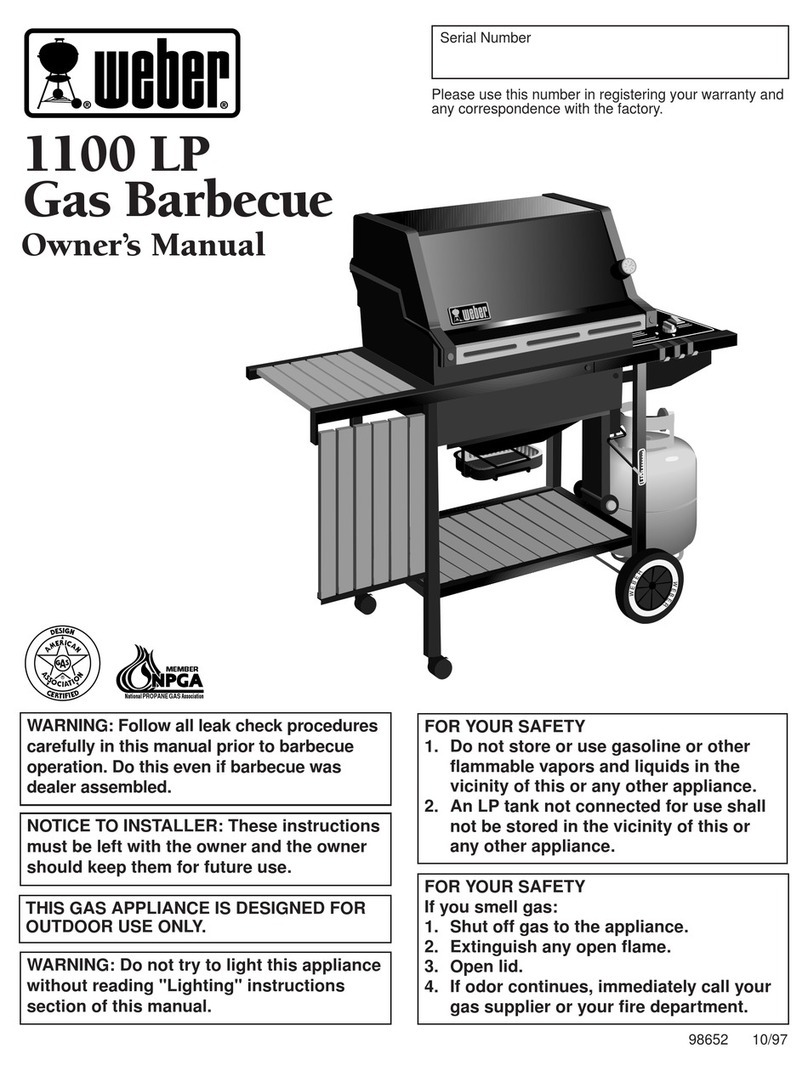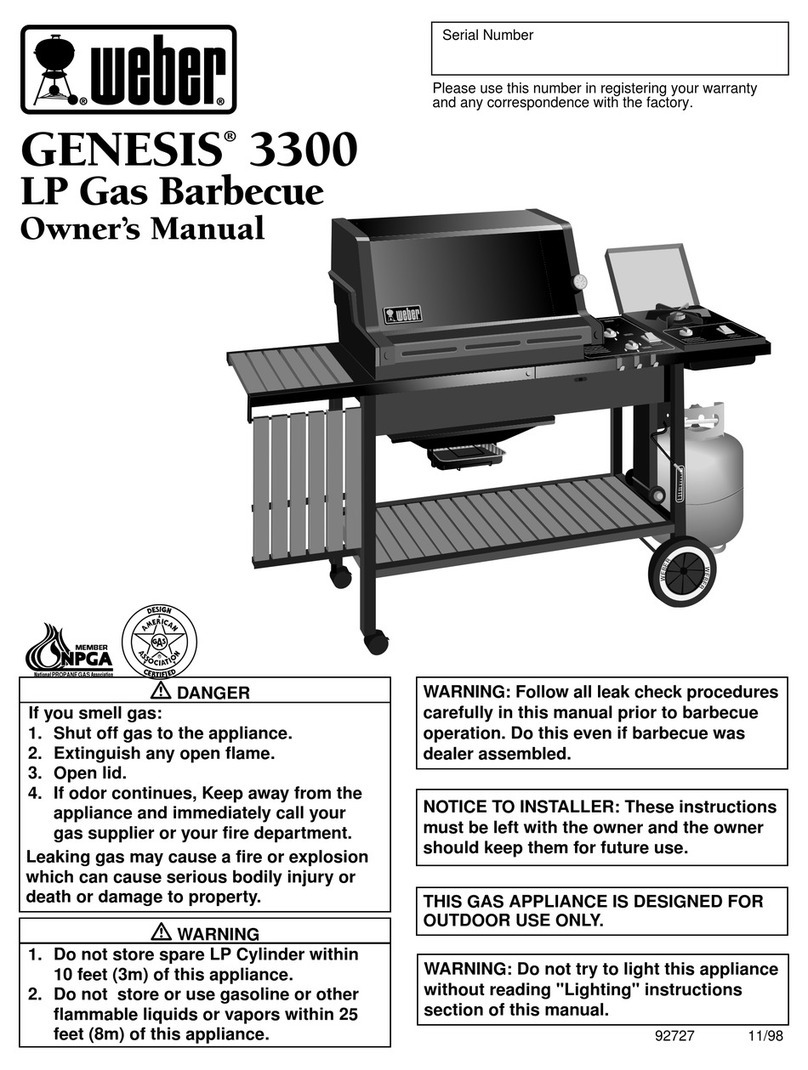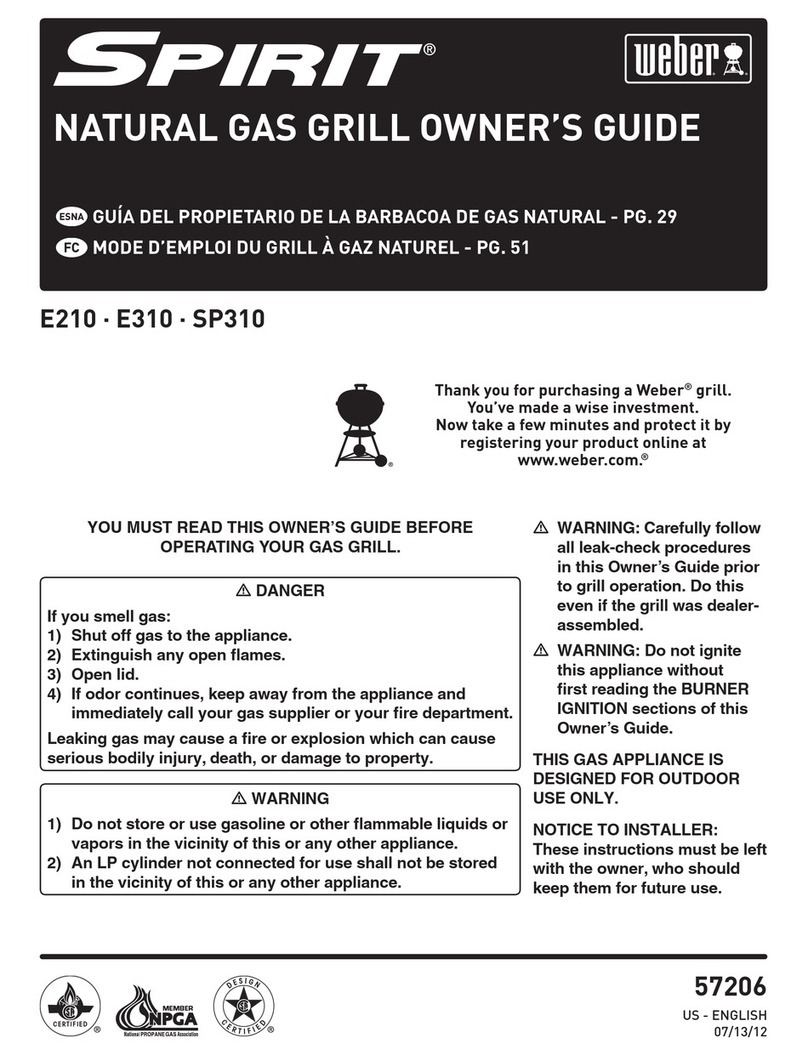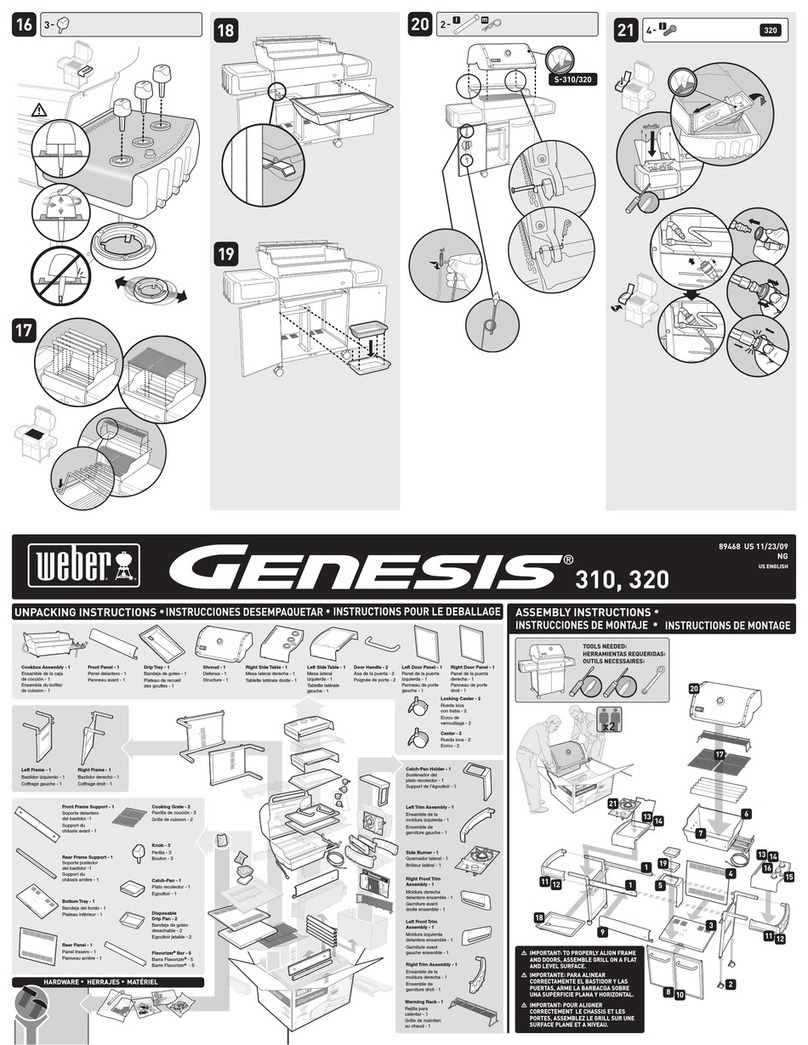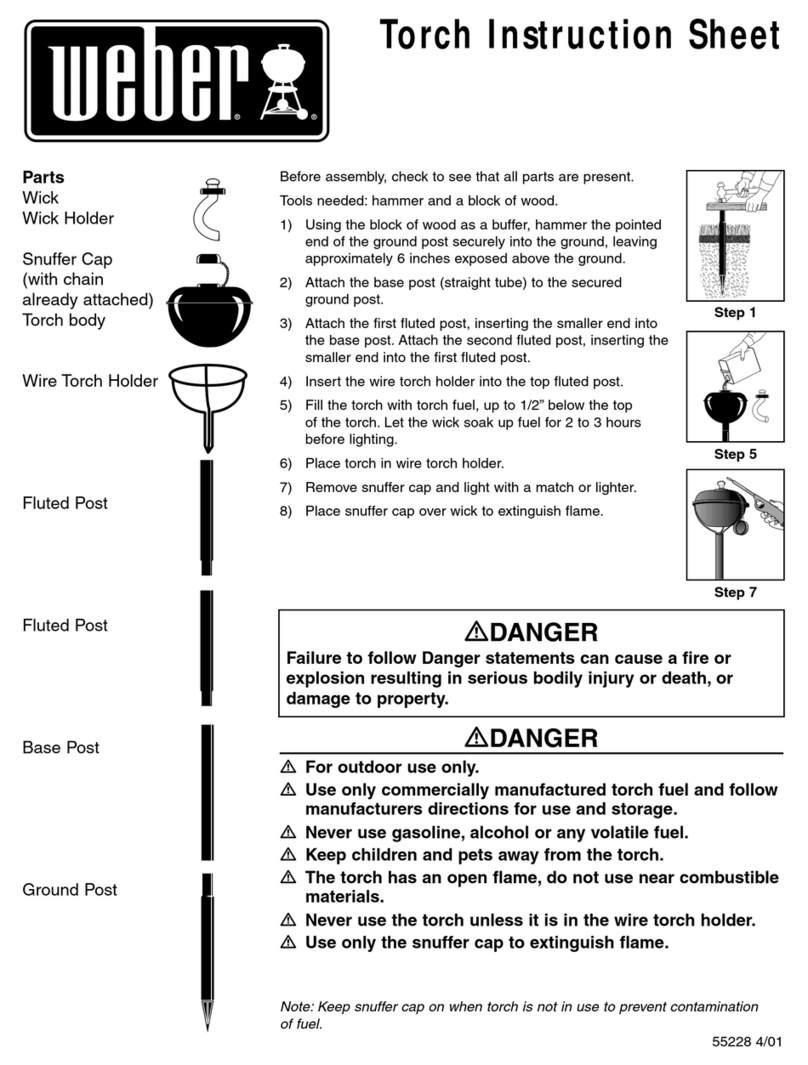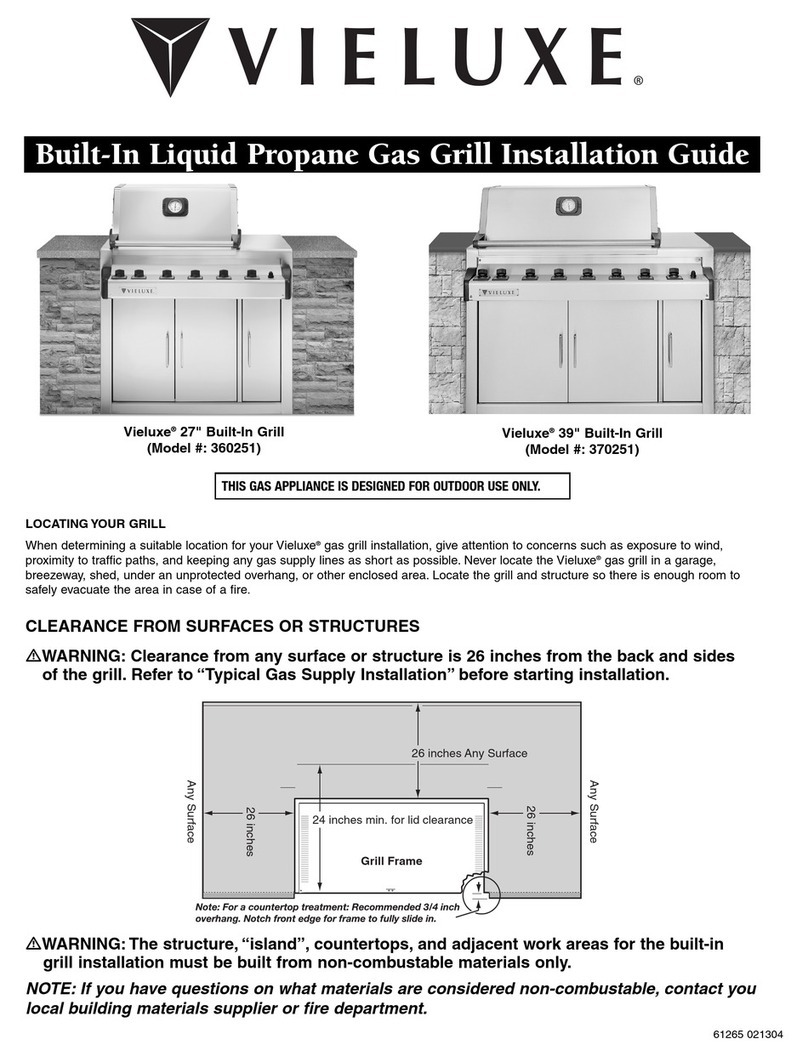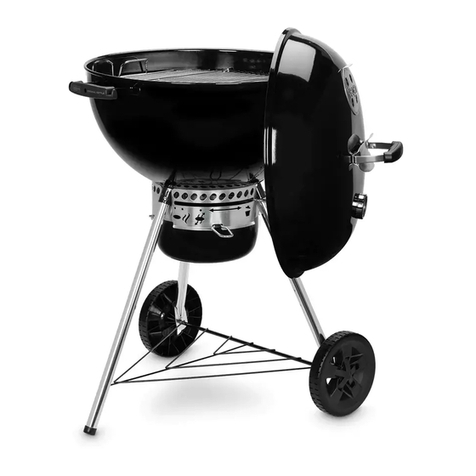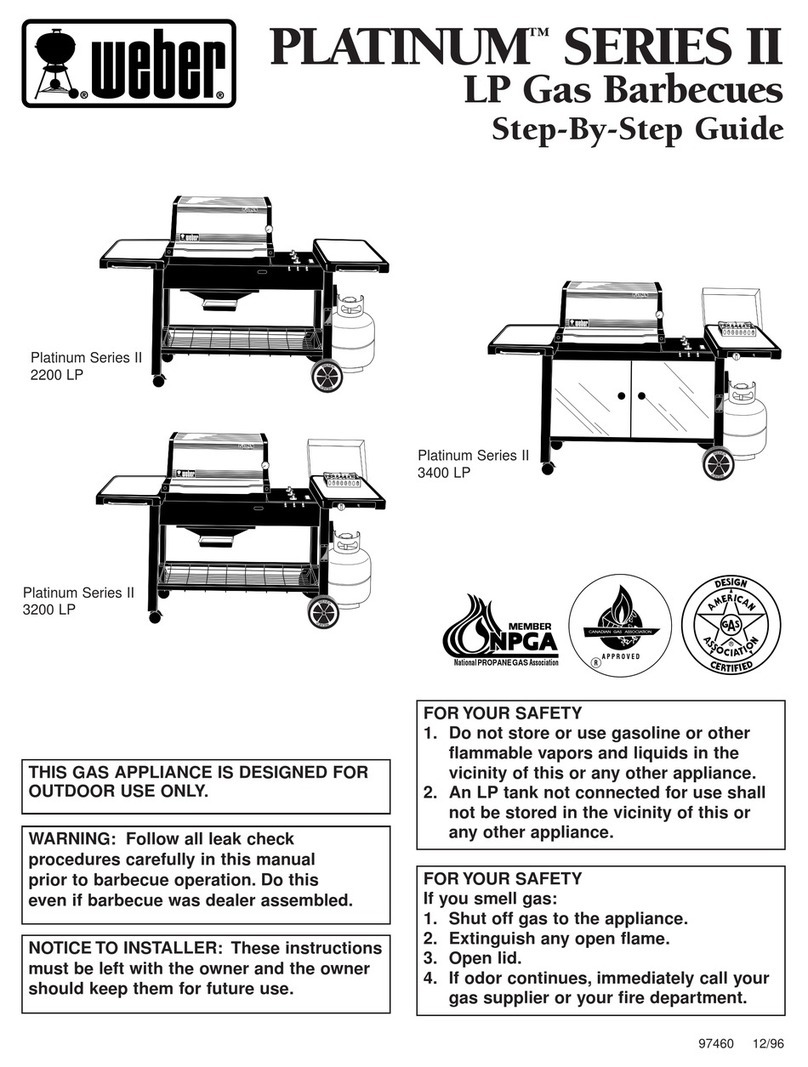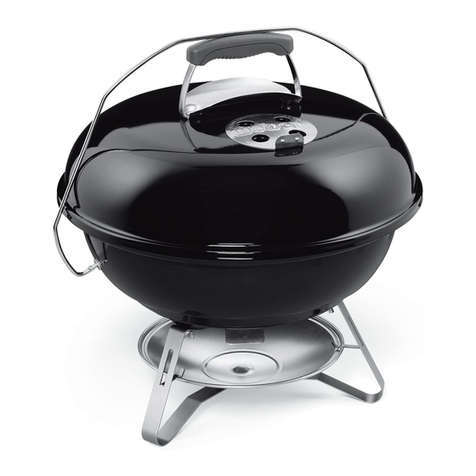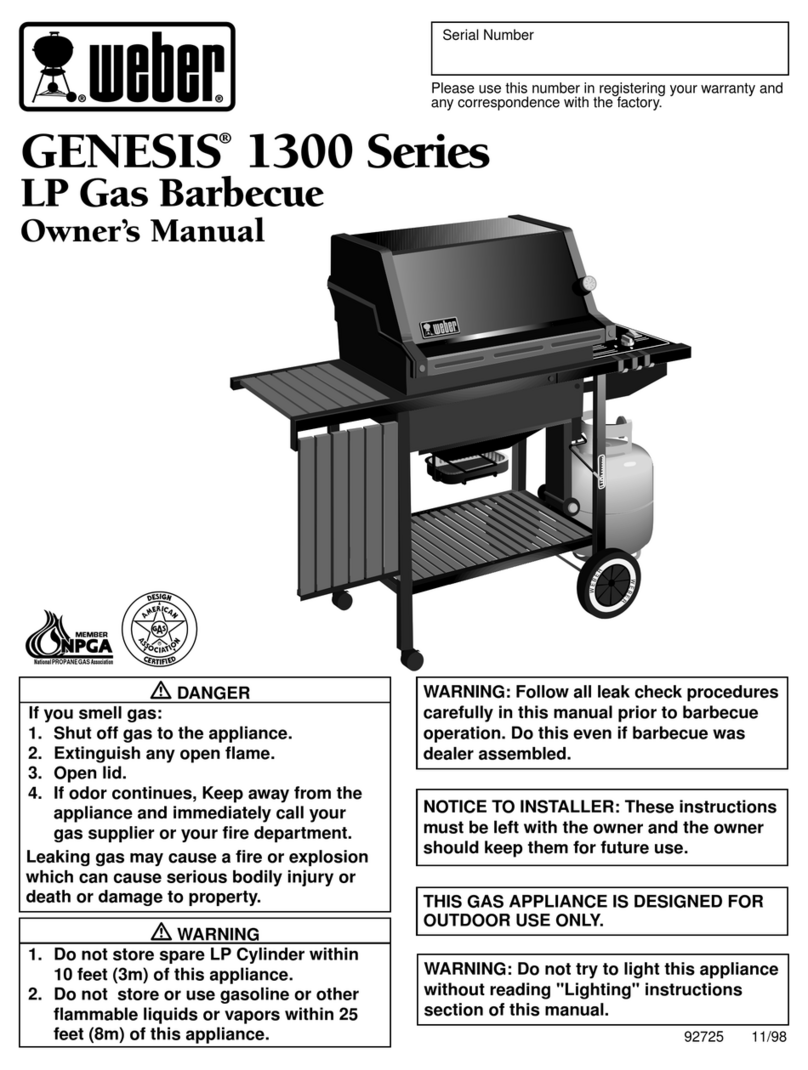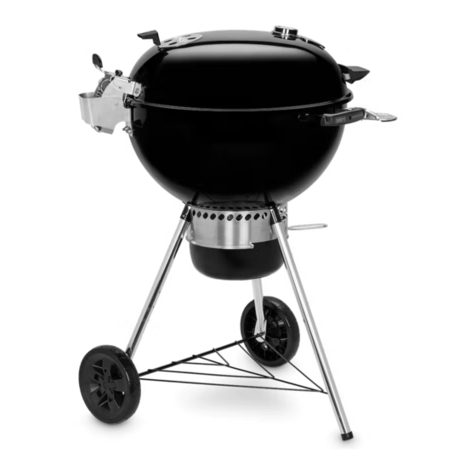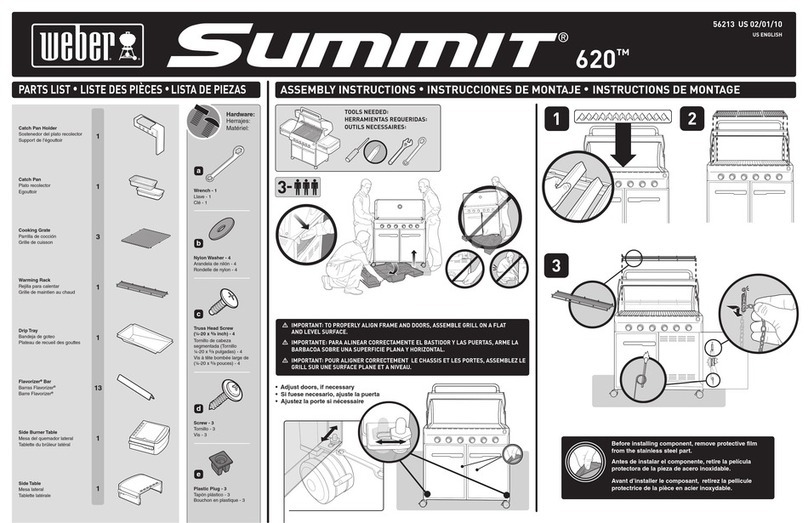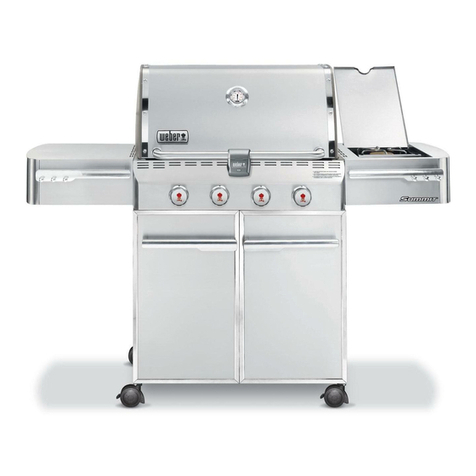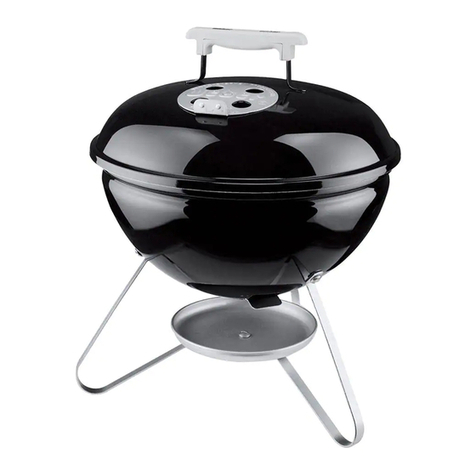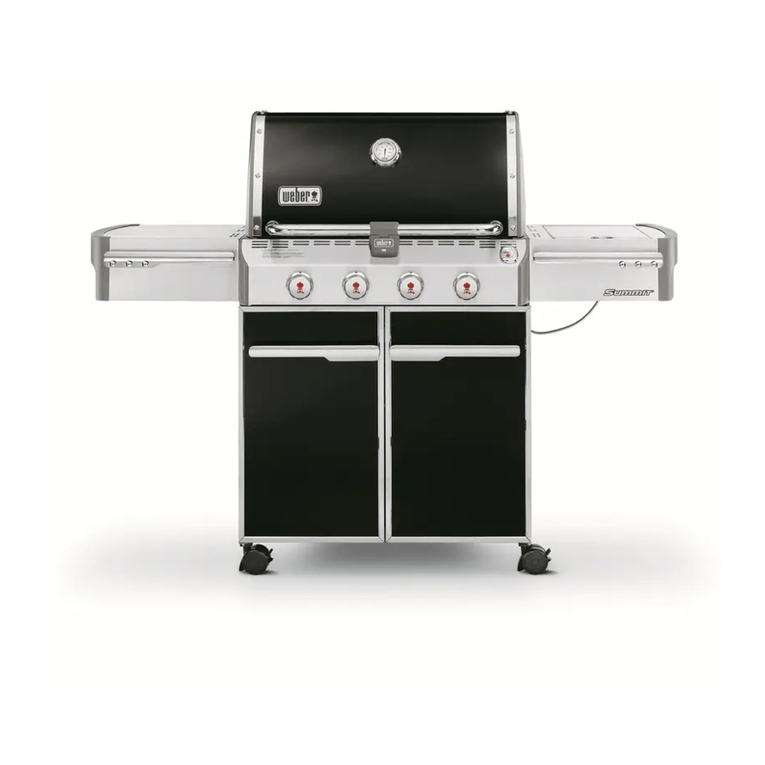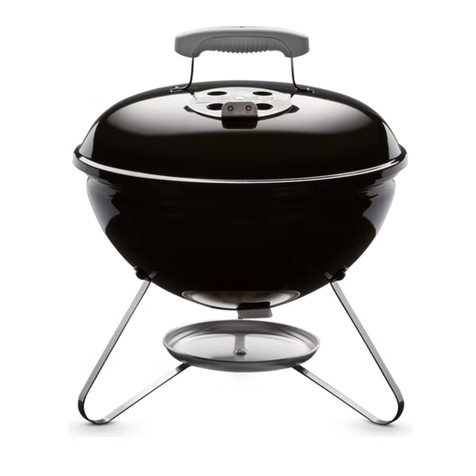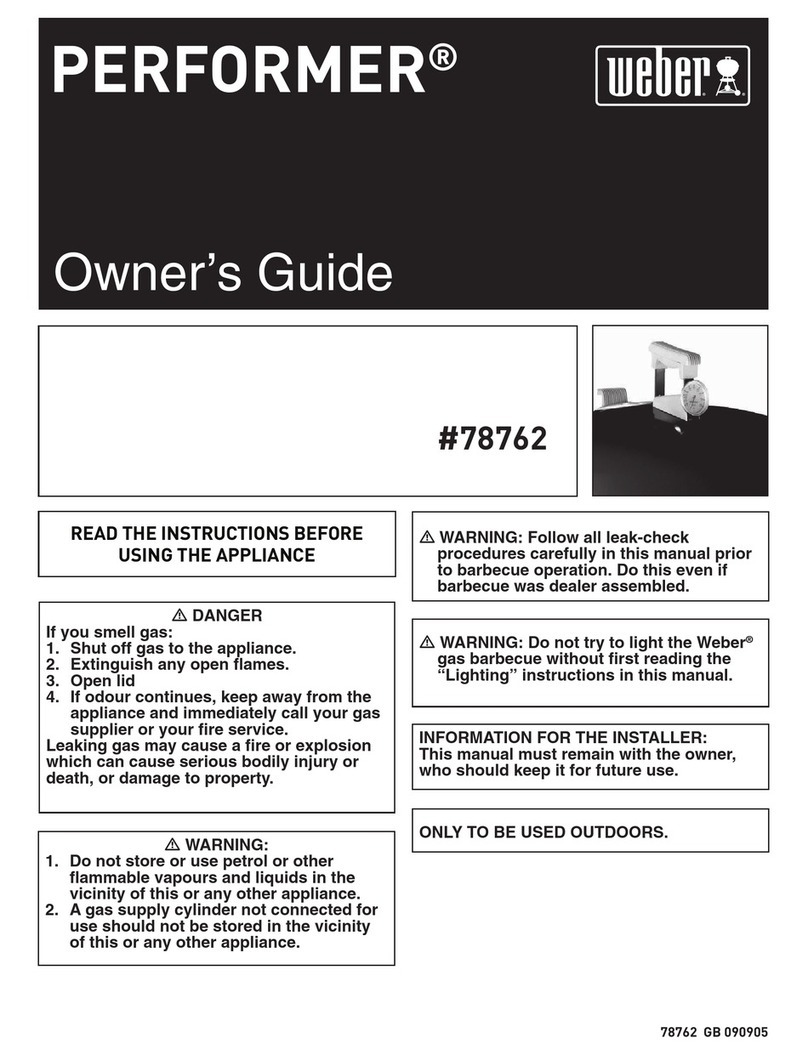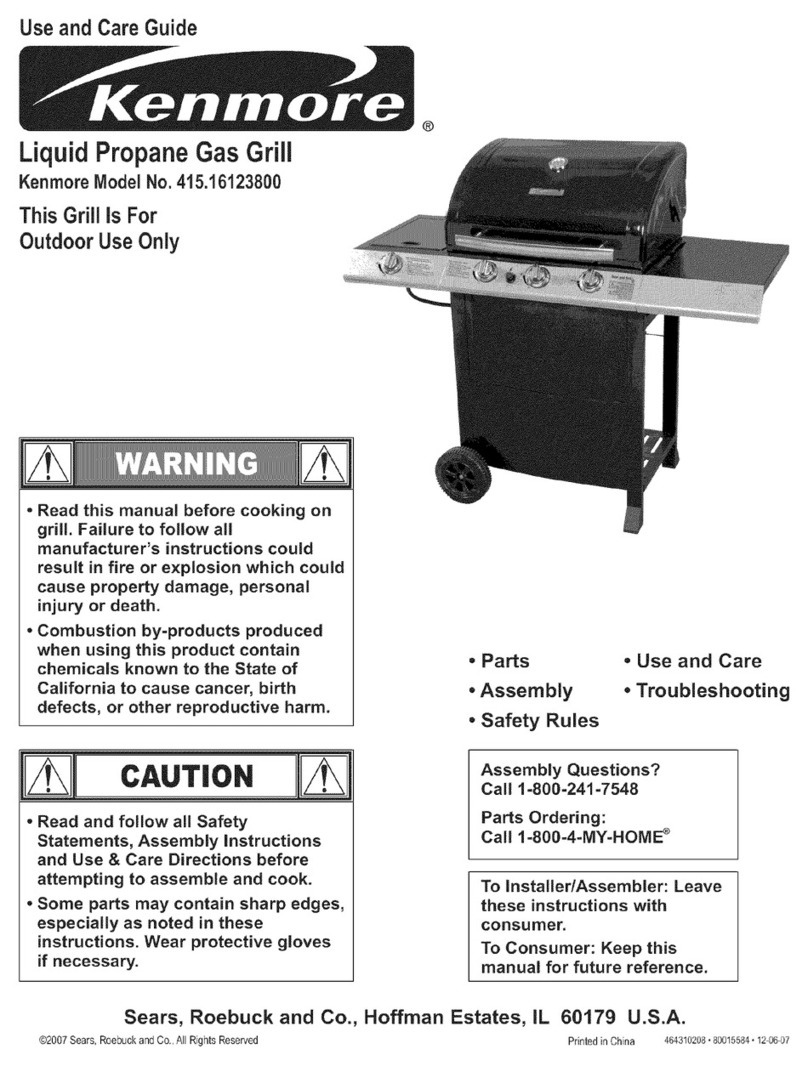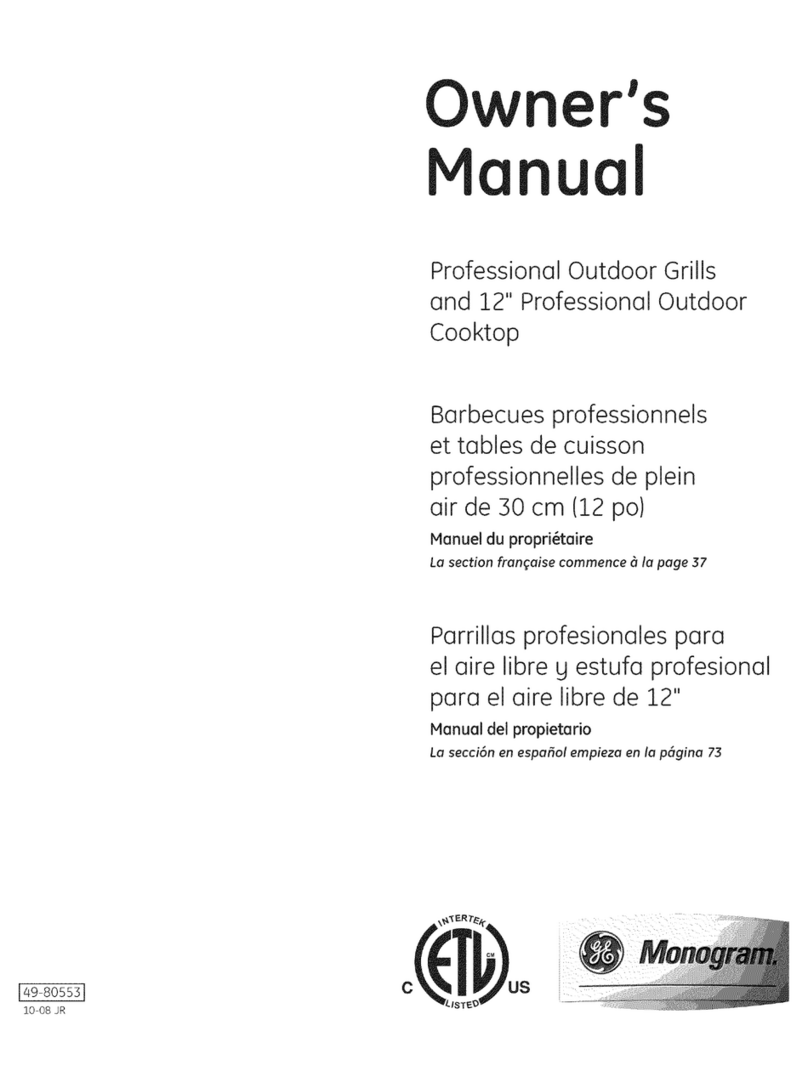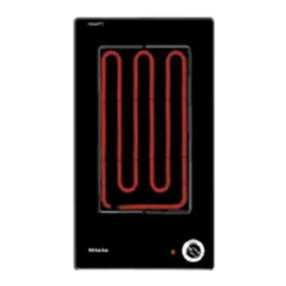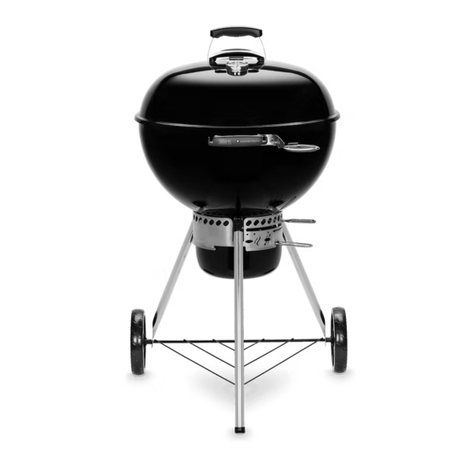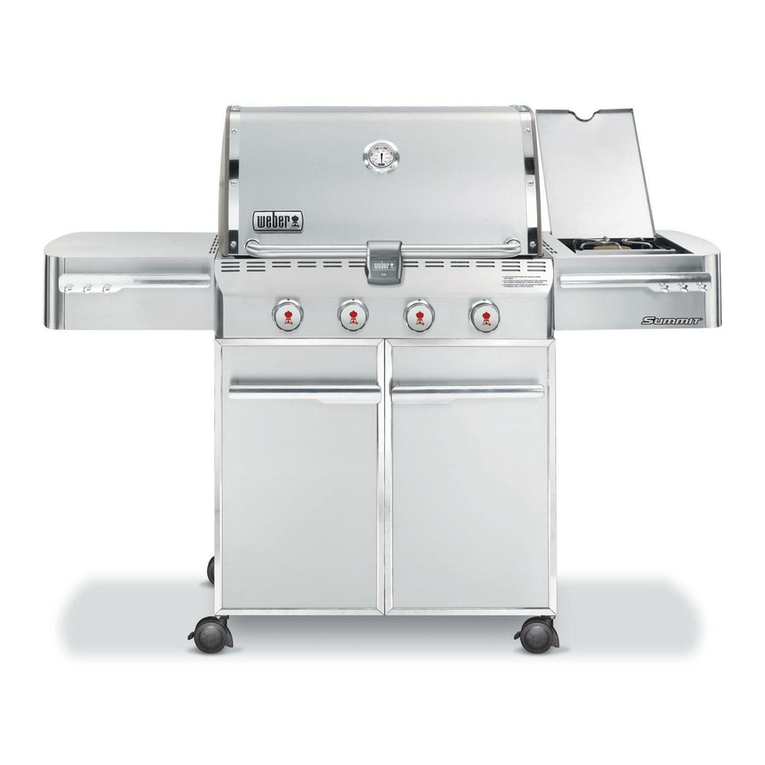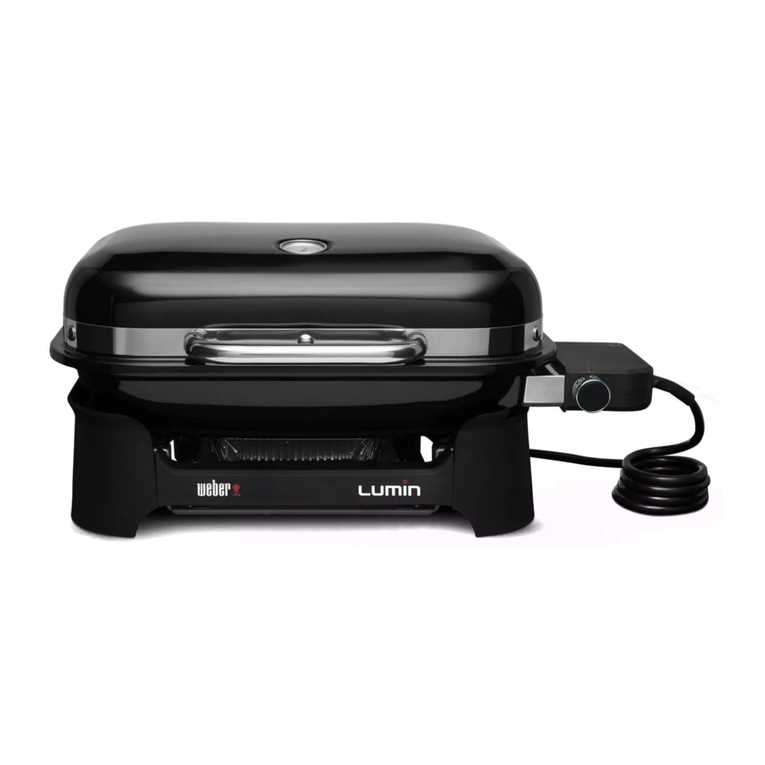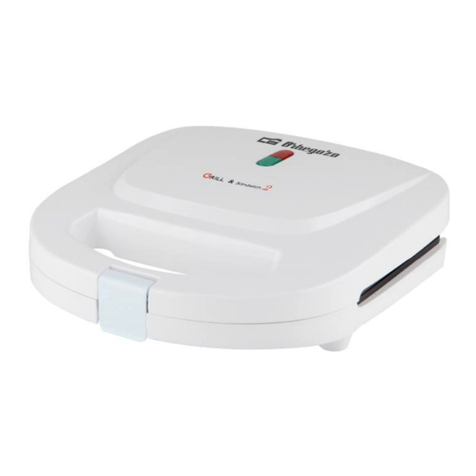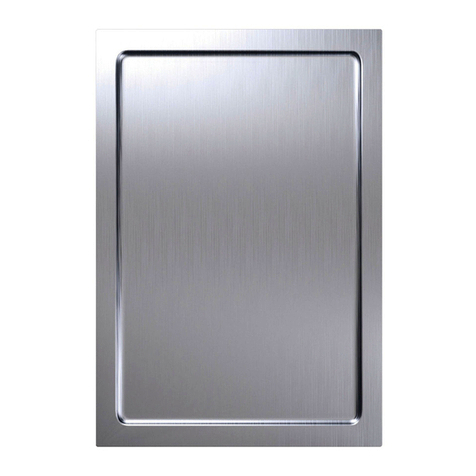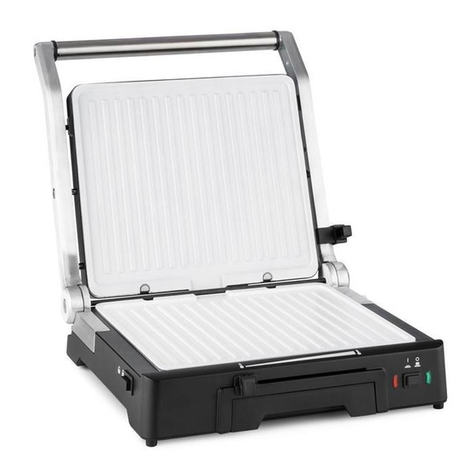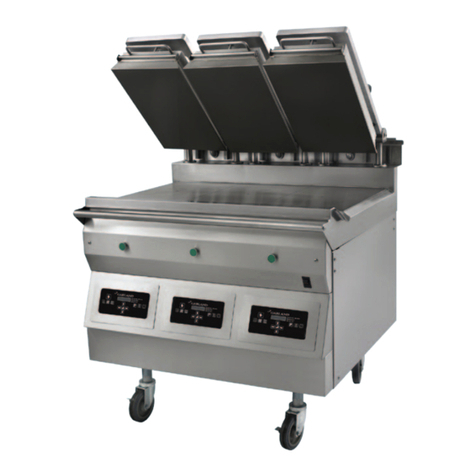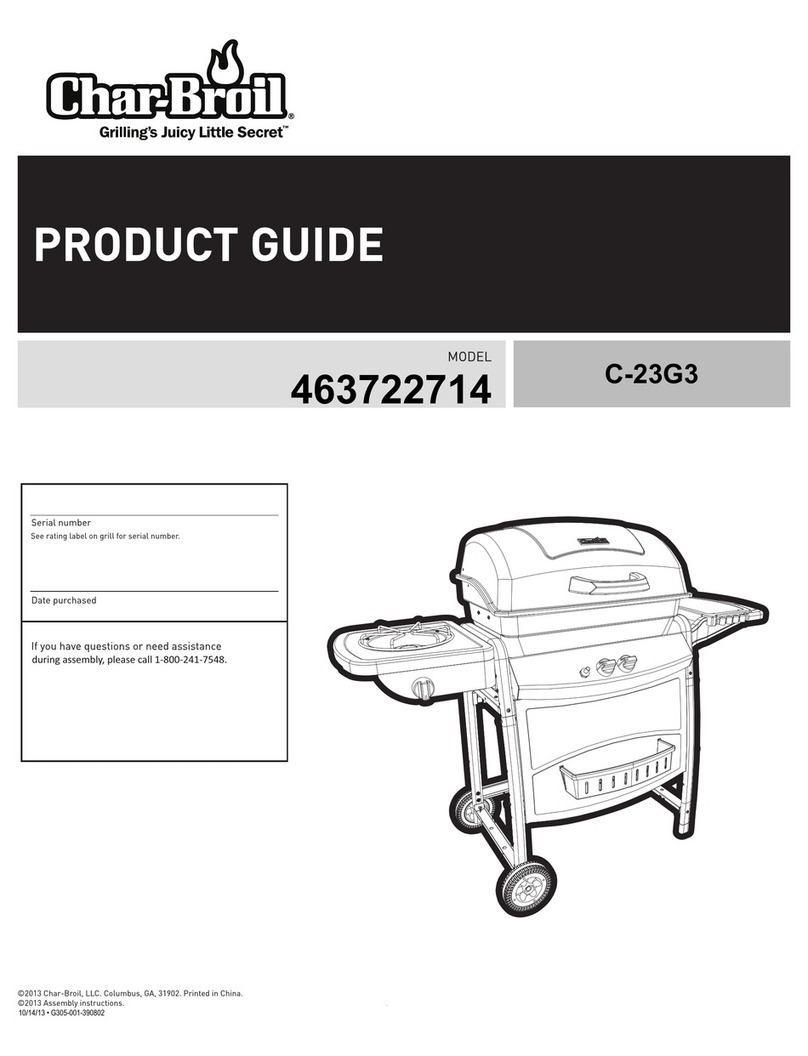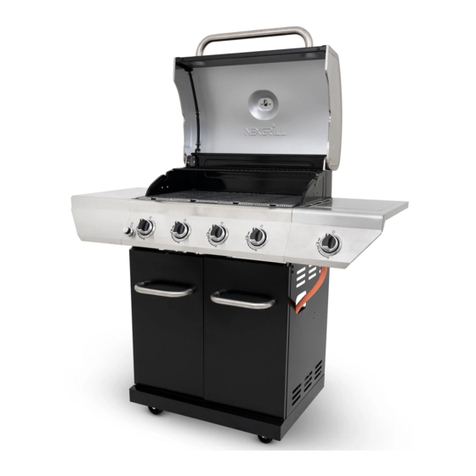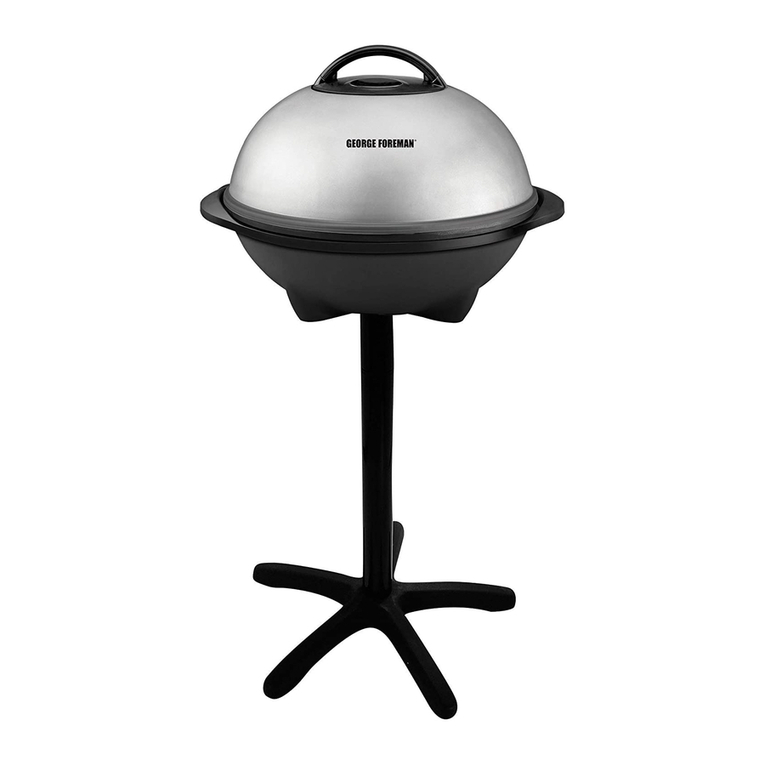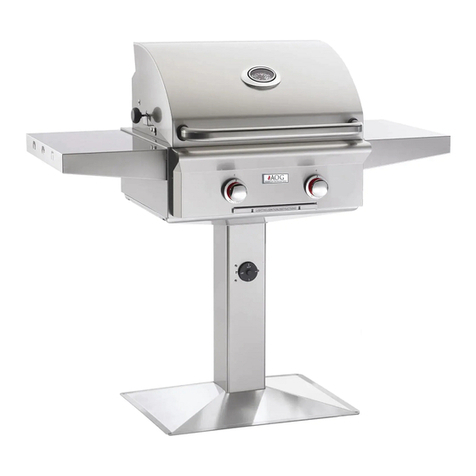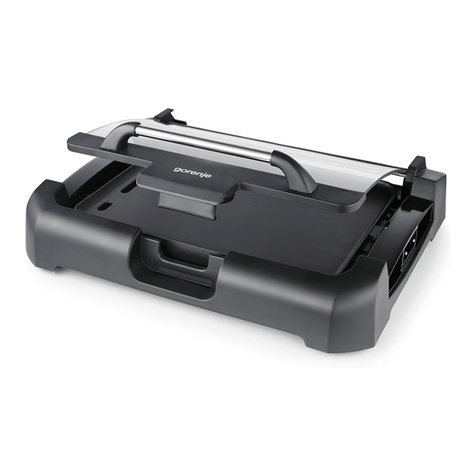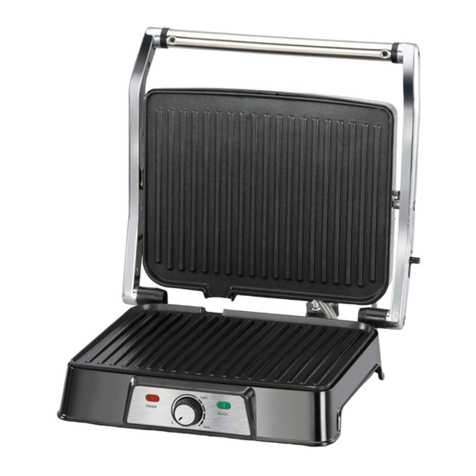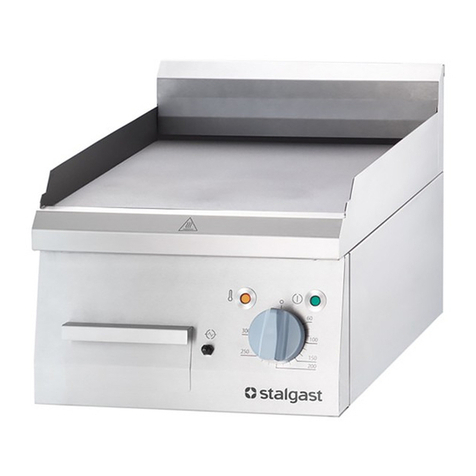
2
• An appliance is considered to be outdoors if installed with
shelter no more inclusive than within a partial enclosure
that included an overhead cover and three sidewalls, as long
as 30% or more of the horizontal periphery of the enclosure
is permanently open. All openings must be permanently
open; sliding doors, garage doors, windows, or screened
openings are not considered as permanent openings.
• The minimum ambient operating temperature for safe use
of the appliance shall be 0° F (-17° C).
mDANGER: Do not use the grill in any vehicle or in any
storage or cargo area of any vehicle. This includes, but
is not limited to, cars, trucks, station wagons, mini-vans,
sport utility vehicles, recreational vehicles, andboats.
mDANGER: Do not use the grill within 24 inches (61 cm)
of combustible materials. This includes the top, bottom,
back and sides of the grill.
mDANGER: Keep the cooking area clear of flammable
vapors and liquids such as gasoline, alcohol, etc., and
combustible materials.
mDANGER: This appliance (grill) must be kept away from
flammable materials during use.
mDANGER: Do not put a grill cover or anything flammable
on, or in the storage area under the grill while it is in
operation or is hot.
mDANGER: Should a grease fire occur, turn o all burners
and leave lid closed until fire is out.
mWARNING: Accessible parts may be very hot. Keepyoung
children away.
mWARNING: The use of alcohol, prescription drugs,
non-prescription drugs, or illegal drugs may impair the
consumer’s ability to properly and safely assemble,
move, store, or operate thegrill.
mWARNING: Never leave the grill unattended during pre-
heating or use. Exercise caution when using this grill. The
entire cookbox gets hot when in use.
mWARNING: Do not move the appliance (grill) duringuse.
mWARNING: Keep any electrical supply cord and the fuel
supply hose away from any heated surfaces.
mCAUTION: This product has been safety-tested and is only
certified for use in a specific country. Refer to country
designation located on outside of box.
• Do not use charcoal or lava rock in the grill.
Storage and/or Non-Use
mWARNING: Turn o the gas supply at the gas cylinder
(tank) after use.
mWARNING: LP tanks must be stored outdoors out of the
reach of children and must not be stored in a building,
garage, or any other enclosed space.
mWARNING: After a period of storage and/or nonuse,
the grill should be checked for gas leaks and burner
obstructions before use.
mStorage of the grill indoors is permissible only if the LP
tank is disconnected and removed from the grill.
California Proposition 65
mWARNING: Combustion byproducts produced when
using this product contain chemicals known to the state
of California to cause cancer, birth defects, or other
reproductive harm.
mPROPOSITION 65 WARNING: Handling the brass material
on this product exposes you to lead, a chemical known to
the state of California to cause cancer, birth defects, or
other reproductive harm. Wash hands after handling this
product.
Limited Warranty
Thank you for purchasing a WEBER product. Weber-Stephen
Products LLC, 1415 S. Roselle Road, Palatine, Illinois 60067
(“WEBER”) prides itself on delivering a safe, durable, and
reliableproduct.
This is WEBER’s Limited Warranty provided to you at no extra
charge. It contains the information you will need to have your
WEBER product repaired in the unlikely event of a failure or defect.
Pursuant to applicable laws, the customer has several
rights in case the product is defective. Those rights include
supplementary performance or replacement, abatement of the
purchasing price, and compensation. These and other statutory
rights remain unaffected by this warranty provision. In fact,
this warranty grants additional rights to the Owner that are
independent from statutory warranty provisions.
WEBER’S LIMITED WARRANTY
WEBER warrants, to the purchaser of the WEBER product (or in
the case of a gift or promotional situation, the person for whom it
was purchased as a gift or promotional item) ("Owner"), that the
WEBER product is free from defects in material and workmanship
for the period(s) of time specified below when assembled and
operated in accordance with the accompanying Owner’s Manual,
normal wear and tear excluded . (Note: If you lose or misplace
your WEBER Owner’s Manual, a replacement is available online
at www.weber.com.) WEBER agrees within the framework of this
warranty to repair or replace the part that is defective in material
or workmanship subject to the limitations, and exclusions listed
below. TO THE EXTENT ALLOWABLE BY APPLICABLE LAW, THIS
WARRANTY IS EXTENDED ONLY TO THE ORIGINAL PURCHASER
AND IS NOT TRANSFERABLE TO SUBSEQUENT OWNERS, EXCEPT
IN THE CASE OF GIFTS AND PROMOTIONAL ITEMS AS NOTED
ABOVE.
WEBER stands by its products and is happy to provide you with the
Warranty described for material defects in the grill or its relevant
components, normal wear and tear excepted.
• ‘Normal wear and tear’ includes cosmetic and other immaterial
deterioration that may come with ownership of your grill over
time, such as surface rust, dents / scratches, etc.
However, WEBER will honor this Warranty for the grill or its
relevant components where damage or dysfunction results from
a material defect.
• ‘Material defect’ includes rust through or burn through of certain
parts, or other damage or failure inhibiting your ability to safely /
properly use your grill.
OWNER’S RESPONSIBILITIES UNDER THIS WARRANTY
To ensure trouble-free warranty coverage, it is important (but it
is not required) that you register your WEBER product online at
www.weber.com. Please also retain your original sales receipt
and/or invoice. Registering your WEBER product confirms your
warranty coverage and provides a direct link between you and
WEBER in case we need to contact you. If you have not had time to
register your grill before calling for Warranty service, please have
the following information available when you do call:
Name – Address – Phone Number – Email – Serial Number –
Purchase Date – Purchase Dealer – Model – Color – Primary Issue
The above warranty only applies if the Owner takes reasonable
care of the WEBER product by following all assembly instructions,
usage instructions, and preventative maintenance as outlined in
the accompanying Owner’s Manual, unless the Owner can prove
that the defect or failure is independent of non-compliance with
the above mentioned obligations. If you live in a coastal area, or
have your product located near a pool, maintenance includes
regular washing and rinsing of the exterior surfaces as outlined in
the accompanying Owner’s Manual.
WARRANTY HANDLING / EXCLUSION OF WARRANTY
If you believe that you have a part which is covered by this
Warranty, please contact WEBER Customer Service using the
contact information on our website (www.weber.com, or such
country-specific website to which Owner may be redirected).
WEBER will, upon investigation, repair or replace (at its option) a
defective part that is covered by this Warranty. In the event that
repair or replacement are not possible, WEBER may choose (at its
option) to replace the grill in question with a new grill of equal or
greater value. WEBER may ask you to return parts for inspection,
shipping charges to be pre-paid by owner.
When you contact Customer Service, please have the following
information available:
Name – Address – Phone Number – Email – Serial Number –
Purchase Date – Purchase Dealer – Model – Color – Primary Issue
This WARRANTY lapses if there are damages, deteriorations,
discolorations, and/or rust for which WEBER is not responsible
caused by:
• Abuse, misuse, alteration, modification, misapplication,
vandalism, neglect, improper assembly or installation, and
failure to properly perform normal and routine maintenance;
• Insects (such as spiders) and rodents (such as squirrels),
including but not limited to damage to burner tubes and/or gas
hoses;
• Exposure to salt air and/or chlorine sources such as swimming
pools and hot tubs/spas;
• Severe weather conditions such as hail, hurricanes,
earthquakes, tsunamis or surges, tornadoes or severe storms.
• Acid rain and other environmental factors.
Using third party parts will not void this Warranty. However, any
parts that are used and/or installed on your WEBER product that
are not genuine WEBER parts are not covered by this Warranty. In
addition, any damages that result from the use and/or installation
of parts on your WEBER product that are not genuine WEBER parts
are not covered by this Warranty. Any conversion of a gas grill
not authorized by WEBER and performed by a WEBER authorized
service technician will void this Warranty.
PRODUCT WARRANTY PERIODS
Cookbox:
5 years, no rust through/burn through
(2 years paint, excluding fading or discoloration)
Lid assembly:
5 years, no rust through/burn through
(2 years paint, excluding fading or discoloration)
Stainless steel burner tubes:
5 years, no rust through/burn through
Porcelain-enameled cast iron cooking grates:
5 years, no rust through/burn through
Plastic components:
5 years, excluding fading or discoloration
All remaining parts:
2 years
DISCLAIMERS
APART FROM THE WARRANTY AND DISCLAIMERS AS
DESCRIBED IN THIS WARRANTY STATEMENT, THERE ARE
EXPLICITLY NO FURTHER WARRANTY OR VOLUNTARY
DECLARATIONS OF LIABILITY GIVEN HERE WHICH GO BEYOND
THE STATUTORY LIABILITY APPLYING TO WEBER. THE
PRESENT WARRANTY STATEMENT ALSO DOES NOT LIMIT
OR EXCLUDE SITUATIONS OR CLAIMS WHERE WEBER HAS
MANDATORY LIABILITY AS PRESCRIBED BY STATUTE.
NO WARRANTIES SHALL APPLY AFTER THE APPLICABLE
PERIODS OF THIS WARRANTY. NO OTHER WARRANTIES
GIVEN BY ANY PERSON, INCLUDING A DEALER OR RETAILER,
WITH RESPECT TO ANY PRODUCT (SUCH AS ANY “EXTENDED
WARRANTIES”), SHALL BIND WEBER. THE EXCLUSIVE REMEDY
OF THIS WARRANTY IS REPAIR OR REPLACEMENT OF THE
PART OR PRODUCT.
IN NO EVENT UNDER THIS WARRANTY SHALL RECOVERY OF
ANY KIND BE GREATER THAN THE AMOUNT OF THE PURCHASE
PRICE OF THE WEBER PRODUCT SOLD.
YOU ASSUME THE RISK AND LIABILITY FOR LOSS, DAMAGE, OR
INJURY TO YOU AND YOUR PROPERTY AND/OR TO OTHERS AND
THEIR PROPERTY ARISING OUT OF THE MISUSE OR ABUSE
OF THE PRODUCT OR FAILURE TO FOLLOW INSTRUCTIONS
PROVIDED BY WEBER IN THE ACCOMPANYING OWNER’S
MANUAL.
PARTS AND ACCESSORIES REPLACED UNDER THIS WARRANTY
ARE WARRANTED ONLY FOR THE BALANCE OF THE ABOVE
MENTIONED ORIGINAL WARRANTY PERIOD(S).
THIS WARRANTY APPLIES TO PRIVATE SINGLE FAMILY HOME
OR APARTMENT USE ONLY AND DOES NOT APPLY TO WEBER
GRILLS USED IN COMMERCIAL, COMMUNAL OR MULTI-UNIT
SETTINGS SUCH AS RESTAURANTS, HOTELS, RESORTS, OR
RENTAL PROPERTIES.
WEBER MAY FROM TIME TO TIME CHANGE THE DESIGN OF ITS
PRODUCTS. NOTHING CONTAINED IN THIS WARRANTY SHALL
BE CONSTRUED AS OBLIGATING WEBER TO INCORPORATE
SUCH DESIGN CHANGES INTO PREVIOUSLY MANUFACTURED
PRODUCTS, NOR SHALL SUCH CHANGES BE CONSTRUED AS
AN ADMISSION THAT PREVIOUS DESIGNS WERE DEFECTIVE.
Weber-Stephen Products LLC
Customer Service Center
1415 S. Roselle Road
Palatine, IL 60067
U.S.A.
For replacement parts, call:
1-800-446-1071
GETTING STARTED
